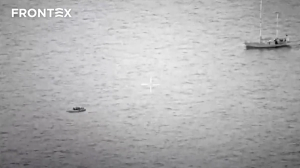Asymmetric Visions
Central Mediterranean
Since 2017 European authorities, and in particular Frontex, have increasingly relied on a comprehensive network of manned and unmanned aircraft operated by private contractors to monitor the presence of migrant boats in the Central Mediterranean. While Frontex maintains that aerial surveillance helps to save lives at sea, several investigations, including our own, have demonstrated that it is used to provide the Libyan Coast Guard with the information they need to capture them, knowing full well the arbitrary detention, violence, and exploitation migrants face upon return to Libya. Aerial patrols have thus become a central plank of the EU’s strategy to prevent asylum seekers from reaching Europe by boat.
In the summer of 2021 Frontex added to its increasing aerial arsenal a remote-piloted Heron drone flying out of Malta airport. Built by Israeli Aerospace Industries and operated by a subsidiary of Airbus, the drone has arguably become a cornerstone of Frontex aerial operations as it can fly for longer hours closer to the Libyan coast, where migrant boats can be more easily intercepted by the Libyan Coast Guard. The operational patterns and sensory capabilities of the Frontex drone, however, remain shrouded in secrecy. Few public documents specify to any level of detail why or when the drone is used, nor what it can detect and how, leaving the understanding of the drone’s role in the interceptions by the Libyan Coast Guard obscured and incomplete.
Through open-source research, forensic methods, data, and image analysis we carried out an investigation to answer a simple question: how does the drone see? By relying on a trail of public tender documents, flight data, witness testimonies, incident reports and images obtained through Freedom of Information requests and parliamentary questions, we were able to reconstruct moments of confirmed interactions between the Frontex drone and vessels at sea.
Our research findings compiled into this 11-minute animation which sets out to further our understanding of the drone’s sensory capabilities, through the confirmation of minimum ranges of its onboard optical1 and non-optical2 sensors. Moreover, the video also seeks to account for the embodied experience of those travelling by boat across the deadliest migration route in the world, for whom the drone remains an inconspicuous and elusive presence, often just barely audible and indifferent to their fate.
Asymmetric Visions has been shown within the context of international festivals and exhibitions such as the Venice Biennale as part of the Archive of Disobedience, curated by Marco Scotini, and the 2023 KIKK Festival; an international festival of digital & creative cultures exploring the crossovers between art, science & technology.
Frontex [@Frontex] (2022) Recently, our surveillance plane detected a rubber boat adrift in the Central Mediterranean and immediately broadcasted a Mayday to all nearby vessels. The rescue was performed by an NGO vessel which was close to the incident ↗

Still from Frontex Youtube Video "Frontex Up Close", published on the 1st of August 2022 showing a Heron Drone next to Crete ↗

Team & funding
Core Team
Extended Team
Collaborators
Funding
Resources
Parliamentary Questions
DEMIREL, Özlem. “Parliamentary Question | Surveillance Sensor Technology of Frontex Drones in the Central Mediterranean | E-002455/2021 | European Parliament.” Accessed August 23, 2024. ↗
“Parliamentary Question | Answer for Question E-002455/21 | E-002455/2021(ASW) | European Parliament.” Accessed August 23, 2024. ↗
Product Manuals
“MALE UAS : Heron - High-Resolution Intelligence Gathering,” July 24, 2023. ↗
Frontex Social Media
Flight Data
“ADS-B Exchange - Track Aircraft Live.” ↗






